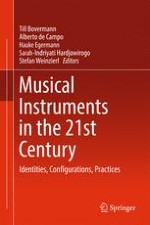2017 | OriginalPaper | Chapter
Interfacing Sound: Visual Representation of Sound in Musical Software Instruments
Author : Thor Magnusson
Published in: Musical Instruments in the 21st Century
Publisher: Springer Singapore
Activate our intelligent search to find suitable subject content or patents.
Select sections of text to find matching patents with Artificial Intelligence. powered by
Select sections of text to find additional relevant content using AI-assisted search. powered by
